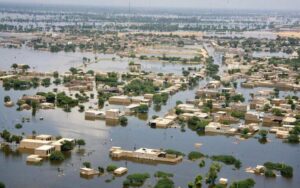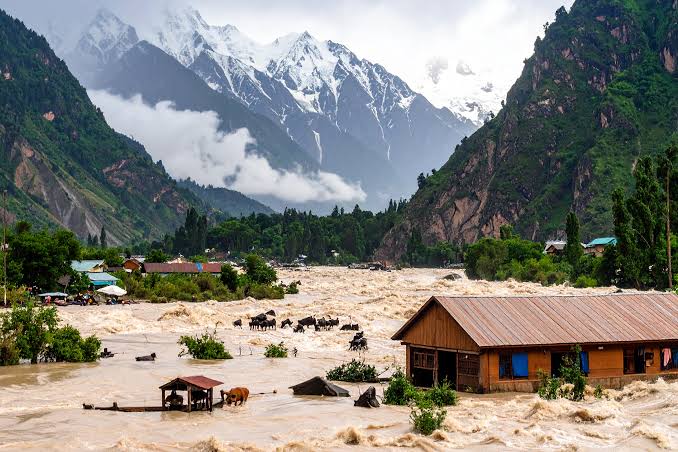Pakistan Flood Latest News 2025

Pakistan Flood Latest News 2025: Impact, FFD Report, and Future Risks

Pakistan has once again been struck by a severe flood crisis in 2025, primarily triggered by the release of water from India. According to the Federal Flood Commission (FFD), river levels in Ravi, Chenab, and Sutlej have crossed dangerous thresholds, resulting in widespread flooding across Punjab and other vulnerable regions. This disaster has left thousands of families displaced, crops destroyed, and infrastructure severely damaged. Understanding the scale of destruction, the regions affected, and the upcoming risks is crucial for both public safety and long-term policy planning.
Water Release from India and Its Impact on Pakistan
The flood situation worsened when India released massive amounts of water into rivers flowing towards Pakistan. This sudden release caused the Ravi, Chenab, and Sutlej to overflow beyond their safe capacity. The FFD reported that water levels were marked as “Exceptionally High,” particularly in areas where embankments were already weak. This uncontrolled inflow not only threatened villages near the rivers but also placed major cities and towns at high risk. Farmers, in particular, were hit hard, as their standing crops were washed away within hours, leading to a devastating blow to the agricultural economy.
Areas Severely Affected by the Floods

The FFD report highlights several districts that have borne the brunt of this year’s floods. In Punjab, the most affected areas include Narowal, Sialkot, Gujranwala, Hafizabad, and parts of Multan. Villages along the banks of Ravi and Sutlej have been submerged, while low-lying areas near Chenab have faced heavy losses. Reports confirm that thousands of homes have been damaged, forcing residents to seek shelter in schools, government buildings, and temporary relief camps. Rural communities, where resources are limited, are suffering the most as rescue operations remain slow due to continuous high water levels.
Humanitarian Crisis and Displacement
One of the most tragic outcomes of this flood is the displacement of people. Thousands of families have been uprooted from their villages, losing not only their homes but also their means of livelihood. Relief camps set up by government and NGOs are overcrowded, with insufficient food, medicine, and clean drinking water. Children and elderly people are particularly vulnerable as diseases like diarrhea, cholera, and malaria spread quickly in such conditions. The humanitarian crisis is intensifying each day, demanding immediate attention from both local and international organizations.
Damage to Agriculture and Livelihood
Agriculture, which forms the backbone of Pakistan’s economy, has suffered severe damage due to the floods. Fields of cotton, rice, sugarcane, and maize have been destroyed, leaving farmers helpless and financially broken. Livestock losses are also significant, as many animals drowned in the floodwaters. This not only reduces household income but also impacts national food security. Experts warn that if immediate steps are not taken, Pakistan could face shortages of essential crops and a rise in food prices in the coming months.
Infrastructure Loss and Economic Impact
The floods have caused widespread destruction to infrastructure, including roads, bridges, and electricity supply networks. Transportation has been disrupted, making it difficult for rescue teams to reach isolated areas. Schools and hospitals in rural districts have either been submerged or turned into emergency shelters. The economic damage is estimated to be in billions, as industries and businesses in flood-hit regions remain shut. This disaster adds further pressure to Pakistan’s struggling economy, which is already battling inflation and external debt challenges.
FFD Report: Exceptionally High Flood Levels
The Federal Flood Commission (FFD) has issued a critical warning, marking water levels in Ravi, Chenab, and Sutlej as “Exceptionally High.” According to the report, inflows from India have crossed danger levels, and the risk of further flood remains high. The FFD also highlighted that embankments and protective barriers in several districts are under severe pressure, and if not reinforced, they may collapse, causing even greater destruction. The report emphasizes the need for urgent evacuation in vulnerable zones and constant monitoring of river flows in the coming days.
Future Risks and Predictions
Experts believe that the flood crisis is not yet over. Continuous rainfall in the northern regions and additional water releases from India could worsen the situation in September. Districts located downstream, including Bahawalpur, Rahim Yar Khan, and Muzaffargarh, are at risk of facing severe flooding in the coming weeks. The possibility of rivers merging and creating super floods cannot be ruled out. Climate experts also warn that changing weather patterns, caused by global warming, are likely to make such disasters more frequent in the future.
Government and Public Response
The government has initiated rescue and relief operations, but the scale of destruction has made the task extremely difficult. The military, along with local administrations, is using boats and helicopters to evacuate people from flooded villages. International aid has been requested, but timely delivery remains a challenge. At the community level, local volunteers and organizations are working tirelessly to provide food, shelter, and medical supplies. However, the lack of resources and coordination continues to hinder relief efforts.
Long-Term Solutions and Preventive Measures
This flood crisis highlights the urgent need for long-term solutions. Pakistan must invest in building stronger embankments, modern flood forecasting systems, and water storage facilities to reduce dependence on river flows. Effective water-sharing agreements with India are also necessary to prevent sudden water releases from creating humanitarian disasters. Climate adaptation strategies, such as rainwater harvesting, improved drainage systems, and sustainable urban planning, must be prioritized to reduce the impact of future floods.
Conclusion
The august 2025 flood crisis in Pakistan, triggered by water releases from India, has exposed the country’s vulnerability to natural disasters. From the destruction of homes and crops to the displacement of thousands of families, the damage is extensive and long-lasting. While immediate relief and rescue operations remain a priority, Pakistan must also focus on long-term strategies to safeguard its people and economy from recurring flood threats. Only through strong planning, international cooperation, and climate resilience policies can the country hope to prevent such tragedies in the future.


zsq1w9